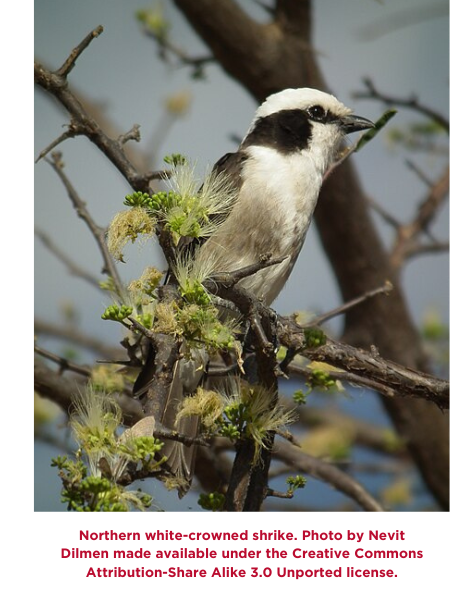Jenna McCullough reclassifies northern and southern white-crowned shrikes
By Mariah Rosales
 For the last 170 years, biologists and researchers were unsure about the classification of two types of birds, specifically shrikes, that are located in the central and southern African region. University of New Mexico (UNM) Biology PhD student Jenna McCullough became curious about this mystery; one that would ultimately lead to the research and discovery of a new bird family, Eurocephalidae, the white-crowned shrikes.
For the last 170 years, biologists and researchers were unsure about the classification of two types of birds, specifically shrikes, that are located in the central and southern African region. University of New Mexico (UNM) Biology PhD student Jenna McCullough became curious about this mystery; one that would ultimately lead to the research and discovery of a new bird family, Eurocephalidae, the white-crowned shrikes.
Prior to formally beginning graduate school at UNM, McCullough began working with her future academic advisor, Dr. Michael Andersen, on a project detailing the evolutionary history of a large group of songbirds, the Corvides (jays, birds-of-paradise, vangas, and allies). One of the minor results of this study highlighted an interesting relationship within shrikes that McCullough and Andersen looked to explore with a focused follow-up study on the relationships of the shrike family.
For nearly two centuries, northern and southern white-crowned shrikes were considered to be part of the shrike bird family, Laniidae. However, the data that was gathered through McCullough’s extensive research would show that the northern and southern white-crowned shrikes were clearly different from the other shrike species they had known thus far.

This discovery would lead to the confirmation that the white-crowned shrikes were actually not shrikes at all, but instead more closely related to crows and jays. This finding suggested a change in the classification of the northern and southern white-crowned shrikes, and highlighted how scientists are using DNA sequences to find new insights into the evolutionary histories of birds.
In their peer-reviewed research, McCullough and her colleagues formally proposed the two species of white-crowned shrikes to be considered their own bird family, Eurocephalidae.
McCullough says, “Prior to these findings, different authors had noted over the course of 187 years how odd these two species of shrikes were compared to others in the family but they had never proposed white-crowned shrikes as their own family.” The first species of white-crowned shrikes were discovered in 1836; although the genetic makeup of the northern and southern white-crowned shrikes had been briefly questioned by ornithologists over the course of 187 years, it was never formally investigated.

The Center for Advanced Research Computing (CARC) has been integral to McCullough’s research since she began working in the UNM Biology Department in 2016, including her master’s thesis about the examination of tropical birds, and ongoing dissertation research on the bird family, Indo-Pacific kingfishers.
McCullough used CARC resources to process sequence data and analysis for her research on white-crowned shrikes, and has continued using CARC resources throughout her PhD to analyze massive quantities of genetic information of a particular bird family, Todiramphus kingfishers, to understand the tempo and mode of their evolution over the last ten million years. She plans to defend her dissertation in April 2024 and hopes to continue her work as a postdoctoral researcher on avian evolution in the South Pacific.
